Japanese
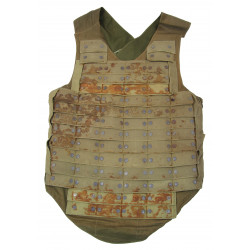
Armor, Body, Japanese, Iron Jacket
Very nice and scarce genuine WWII Japanese body armor, made up of a cloth waistcoat featuring an articulated 'armored' plastron. The latter comprises a total of 72 slightly-curved, rectangular iron plates (2mm), riveted and sewn together in horizontal bands so that every band covers the upper part of the band located underneath. Dimensions of each iron plate: about 3.5cm x 6cm (1.4in x 2.4in). The two wide cloth strips going down from the shoulders and crossing each other in the back are to be attached to the lower part of the waistcoat thanks to a cord and three leather reinforcing strips featuring six eyelets each, in order to conform to the wearer's morphology. The whole assembly can be secured with the tightening strap. In excellent overall condition, this unusual body armor retains its original label, on which the following markings are visible: 武運長久 ( Buun Chōkyū : 'Good fortune in battle'), 新案特許出願中 (New Design Patent Pending), 木村式 ( Kimura Version), 護身用鐵ジョッキー (Self Defense Use Iron Jacket). Probably intended for officers, this type of body armor must have provided relatively poor protection in actual combat conditions...
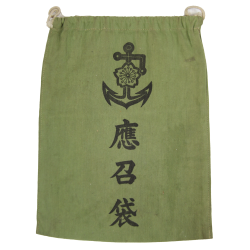
Bag, Personal Belongings, Imperial Japanese Navy, Hoko-bukuro
Great genuine WWII Japanese Hoko-bukuro bag, intended for carrying various personal belongings. Made in light green cotton cloth, it features a drawstring. Excellent overall condition; adorned with the Imperial Japanese Navy insignia. Dimensions: 8.3in x 11in.
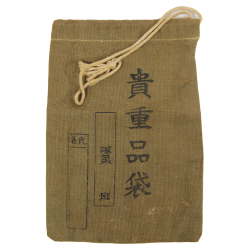
Bag, valuables, Japanese, Imon-bukuro
Great genuine WWII Japanese Imon-bukuro bag, intended for carrying various valuables artifacts. Made in light green cotton cloth, it features a drawstring. Excellent overall condition. Dimensions: 5.5in x 3.7in.
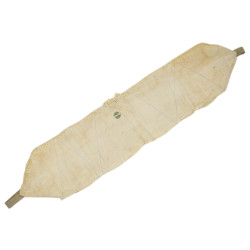
Belt, Good-Luck, Japanese, Senninbari haramaki
Rare genuine WWII Japanese good-luck cloth belt, Senninbari haramaki . Just like the flag offered by families and friends ( Hinomaru yosegaki ) or the war banner given by some local association or patriotic organization, the 'one-thousand stitch belt' is one of the main spiritual protection artifacts carried by the Nipponese serviceman departing for war. Its origins seem to date back to the First Sino-Japanese War (1894-1895). Designed by the warrior's mother, sister, or spouse, it was a participative work, made up of a plain fabric strip intended for being tied around the waist, and on which various motifs and messages of encouragement were to be sewn: traditionally, these inscriptions were supposed to be composed of one thousand stitches and every single stitch was to be embroidered by a different woman at the request of the initiator. The present belt does not feature embroidered motifs, but various ideograms have been painted on the cloth and one single coin was sewn onto it, fulfilling the function of an amulet. Quite good, worn condition.

Belt, Japanese soldier, 1944
Genuine WWII Japanese soldier's canvas belt, with brass buckle. Total length: 160 cm.
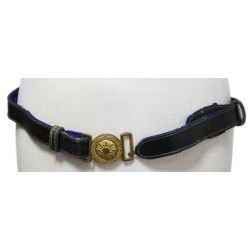
Belt, Leather, Junior Officer, Imperial Japanese Army
Rare genuine WWII Imperial Japanese Army black leather belt, fitted with a brass buckled and probably intended for Junior officers with blue wool liner. Quite good, worn condition, sword holder straps. Length: 95 cm.
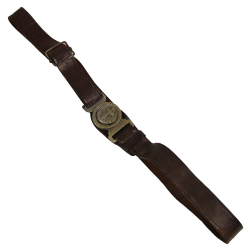
Belt, Leather, Petty Officer, Imperial Japanese Navy
Rare genuine WWII Imperial Japanese Navy brown leather belt, fitted with a brass buckled and probably intended for petty officers. Quite good, worn condition.
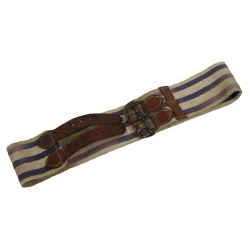
Belt, Support, Imperial Japanese Army, Obigawa
Interesting genuine WWII Japanese support belt, made in heavy duty canvas and fitted with two russet leather straps featuring pin buckles (in working order). Quite good, worn condition. Dimensions of the canvas stripe: 2.9in x 29.5in.
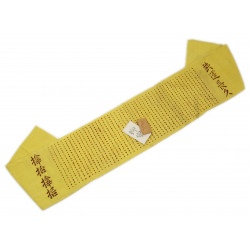
Belt, Thousand Stitch, Japanese, Senninbari haramaki
Very nice genuine WWII Japanese cloth belt, Senninbari haramaki . Just like the good-luck flag offered by families and friends ( Hinomaru yosegaki ) or the war banner given by some local association or patriotic organization ( Shussei nobori ), the 'one-thousand stitch belt' is one of the main spiritual protection artifacts carried by the Nipponese serviceman departing for war. Its origins seem to date back to the First Sino-Japanese War (1894-1895). Designed by the warrior's mother, sister, or spouse, it was a participative work, made up of a plain fabric strip intended for being tied around the waist, on which various motifs and messages of encouragement were to be sewn or inked: traditionally, a total of one thousand stitches had to be embroidered, and every single stitch was to be done by a different woman at the request of the initiator. Made up of yellow material, the present belt is adorned with various ideograms printed on either side of the thousand stiches; a small wooden amulet, protected by a paper envelope, has been slit between the two panels. Excellent overall conditon. Total length: about 44.5in.
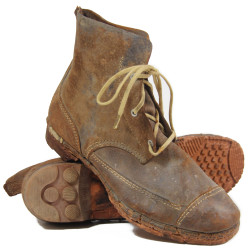
Boots, Ankle, M-16, Imperial Japanese Army, Henjoka
Rare pair of genuine WWII Imperial Japanese Army M-16 combat boots, of the type introduced in February 1941 and intended for being worn with wool puttees. Russet leather ankle boots with toe cap, featuring three pairs of eyelets and a natural rubber sole. Size: 11.7 (US: 10). Homogeneous lot, worn condition; original khaki cotton shoelaces are still present.
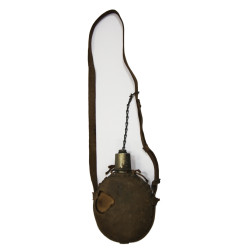
Canteen, Officer, Japanese Imperial Army, Suito
Rare genuine WWII Imperial Japanese Army canteen, of the type intended for officers. Aluminium bottle fitted with a cork plug. A small aluminium cup, designed for being screwed on the bottle's neck, is attached to the canvas sling of the canteen carrier thanks to a small chain. Capacity: 0.3 gal. Complete and in quite good, used condition.
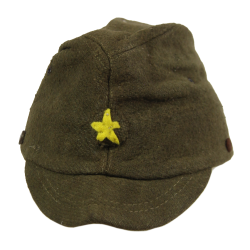
Cap, Field, Other Ranks, Imperial Japanese Army, Ryakubo, Size 7
Rare genuine WWII Imperial Japanese Army Ryakubo field cap, of the type intended for other ranks. Dark olive drab wool hat featuring two ventilation eyelets on each side; soft visor; russet leather sweatband. Size 7 (57). The present peaked cap is in rather good, worn condition, and retains its original cloth insignia and drawstring; the chinstrap is missing.





